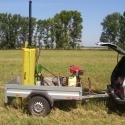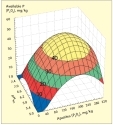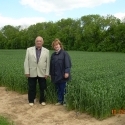23 Mar 2017
Adapting Fertilization Strategies for High Soybean Productivity in Southern Russia
By Vladimir Nosov, Nikolay Tishkov, and Vasiliy Makhonin

Krasnodar Krai is a top soybean-producing region for Southern Russia that lies within the Southern Federal District of Russia. The district, which is located within the 43° and 51° N latitude, plants 200,000 ha of soybean annually, or about 8% of Russia’s total area (ROSSTAT, 2018), however only 27% of this soybean area receives fertilizer. Based on the last five years (2013-2017), average nutrient application rates are estimated at 24-27-9 kg N-P2O5-K2O/ha, respectively. Soybean crops largely depend on residual nutrients from fertilizers applied to other crops grown in rotation.
Recent soybean fertility research in Krasnodar Krai had settled on agronomic optimum rates of 40-80-40 kg N-P2O5- K2O/ha for the crop (Onishchenko, 2015). If grown after winter wheat, soybean has shown a slight response to even higher rates (i.e., 60-120-60 kg N-P2O5-K2O/ha). Research with foliar products has shown promise as highest increases in seed and protein yield of soybean are achieved when ammonium molybdate and soluble complex fertilizer containing chelated forms of Fe, Mn, Zn, Cu, Ca; and inorganic forms of B and Mo are applied at R1 stage (beginning bloom) (Tishkov and Dryakhlov, 2016).
In the neighboring region of Rostov Oblast, the highest yield of soybean has been obtained with application of 30- 45-30 kg N-P2O5-K2O/ha. This has resulted in up to 25% more yield over the average grower practice of applying 9-40 kg N-P2O5/ha (Nosov et al., 2014). This research reports that yield responses to the additional N were not significant during three seasons of study, but higher seed protein contents were obtained. Under irrigation, in soils with high concentrations of available K and medium concentrations of available P, it has been recommended to apply 60-45 kg N-P2O5/ha plus 30 to 60 kg K2O/ha before a preplant cultivation (Guzhvin, 2003).
Besides the general need to improve in-crop nutrition, the region’s changing climate has become a major influence on soybean agronomy. In recent years, increasing drought and high temperatures have often coincided with the critical seed-filling stage of varieties that have an intermediate relative maturity (RM). The higher yield potential that is associated with these longer season soybean crops has been difficult to obtain under such adverse weather conditions.
This article outlines three successive years of adaptive research designed to validate and improve fertilizer recommendations for soybean in Krasnodar Krai.
Study Description
Field experiments were conducted in the western, central, and northern environmental zones of Krasnodar Krai. Locations and initial soil characteristics for each site are given in Table 1. Soils had comparatively low OM; pH varied from slightly acid in the leached Chernozem to neutral in the other soils. Available P and K ranged from medium to high using routine soil tests.
Winter wheat and rice preceded soybean in the northern/central and western environmental zones, respectively. Intermediate maturing var. Vilana (RM = 115 to 118 days) was grown in 2014; var. Vilana and var. Slaviya (early RM = 105 to 112 days) in 2015; and var. Lira (ultra-early RM = 90 to 100 days) in 2016. Seed inoculation was done immediately before sowing. The inoculant was a peat-based seed coating that included a liquid adjuvant and ammonium molybdate used at 50 g (NH4)6Mo7O24· 4H2O/t seed. Soybean was grown in a wide row spacing of 70 cm with crop management recommended by the Russian Research Institute for Oil Crops. Plots, arranged within a systematic experimental design with four replications, varied from 56 to 112 m2 depending on the location. Plots were harvested by specialized combines.
2014
The experimental design in 2014 consisted of six treatments (Table 2). Growing season conditions were unfavorable for the intermediate RM variety that was selected. Precipitation was 25% below normal and not well distributed within the growing season. Temperatures also exceeded the long-term average and extremely hot and dry weather occurred between mid-July at pod development and seed filling stages and continued through August.
Soybean productivity was generally low and the highest seed yield was 1.98 t/ha. Soybean did not respond significantly to fertilizer application at any of the three sites. Potassium chloride (KCl) application resulted in a yield decrease at two sites when 18-78 kg N-P2O5/ha were applied. The spring pre-plant application of KCl accompanied by higher rates of N and P fertilizer at planting likely created high salt concentrations in the overly dry soil.
2015
Nutrient application rates for NP and NPK treatments were adjusted to be slightly lower in 2015, and all treatments were applied as a starter at planting (Table 3). Growing season precipitation was close to normal at the ordinary Chernozem location; however, conditions of hot weather with little rainfall prevailed for the last 10-days of July until August 20th. Growing season precipitation at the leached Chernozem site was above normal, but July, August, and the first 10 days of September were also hotter than average. Flowering and seed filling for the intermediate RM variety occurred under both severe rainfall deficiency and high air temperatures.
Treatment responses were generally low across both maturity groups in 2015, but the early RM variety showed higher productivity. The early RM variety yielded highest at 2.06 t/ha due to the starter NPK application, which was significantly higher than the control. The highest yield for the intermediate RM variety was 1.66 t/ha, which was obtained with starter application of N6P26. Potassium application had no effect on seed yield in both trials.
2016
The experimental design was modified once more in 2016 to study the impact of starter plus foliar fertilization (Table 4). The foliar applications were done at R1 stage using a 0.53% solution at 200 L/ha. For the ordinary Chernozem site, growing season precipitation was about twice the normal amount, while temperatures between June and August were noticeably higher than the long-term averages. The leached Chernozem site had growing season rainfall that was about one-third above normal, but dry weather lasted from seed-filling stage during the second 10-days of July until the end of August.
The ultra-early RM variety performed well during the growing season and was highly responsive to the fertilizer treatments at both sites (Table 4). Foliar fertilizer applied alone resulted in a 6% yield increase compared to the control. This is significant yield improvement from a relatively small amount of soluble fertilizer (~1.0 kg/ha). Under the current economic conditions, this response generates an additional net economic return of 3,000 to 3,200 RUB/ha. However, the combined use of starter + foliar fertilizer produced the highest yields, which were 14 to 17% above the control. The high yields attained at both sites (i.e., 2.68 and 2.88 t/ha) are very close to genetic potential for this shortest duration variety.
Potassium application resulted in a significant but relatively low yield increase at one location. The starter application of MAP at 50 kg/ha (N6P26) combined with the foliar spray delivers an additional net economic return of 4,400 to 4,900 RUB/ha. Research activities need to be continued to develop final recommendations for these short duration soybean varieties.
Taking into consideration that weather predictions cannot be precisely done for the whole growing season it seems reasonable to use fertilizers mainly for short duration soybean varieties that could move yields higher. Short duration soybean varieties planted at the same dates at research farms of the Institute for Oil Crops were generally more productive compared to long duration varieties during the same years. Three years of study conducted under various environmental conditions allow the following preliminary conclusions:
• Due to the prevailing conditions of inadequate precipitation and high temperatures between late July and mid August, the genetic potential may be best realized for shorter duration soybean varieties, which still prove to be highly responsive to fertilizer application.
• Starter P fertilizer appears an agronomically and economically sound choice when growing short duration varieties on soils with medium concentrations of available P.
• Short duration soybean responded significantly to foliar fertilization applied at R1 stage, but further yield increases may be achieved by combining both starter and foliar fertilizer.
Dr. Nosov is director, IPNI Southern and Eastern Russia Region, Krasnodar; e-mail: vnosov@ipni.net. Dr. Tishkov is head, Agro-Technology Dept. and Dr. Makhonin is lead researcher, Russian Research Institute for Oil Crops, Krasnodar; e-mail: agrohim@vniimk.ru.
References
Guzhvin, S.A. 2003. Soybean Fertilization System on Ordinary Chernozem in Rostov Oblast, Ph.D. Dissertation, Persianovskiy, Russia, 200 p. (In Russian).
Nosov, V.V. et al. 2014. Better Crops 93(3):10-12.
Onishchenko, L.M. 2015. Agrochemical Basics for Building Soil Fertility of Leached Chernozem in Western Ciscaucasia and Increasing Crop Productivity, Doctorate Dissertation, Krasnodar, Russia, 668 p. (In Russian).
ROSSTAT, 2018. http://www.gks.ru
Tishkov, N.M. and A.A. Dryakhlov 2016. Oil Crops. Scientific-Technical Bulletin of Russian Research Institute for Oil Crops, 1 (165):81-87. (In Russian).
WRB, 2006. http://www.fao.org/soils-portal/soil-survey/soil-classification/world-reference-base




